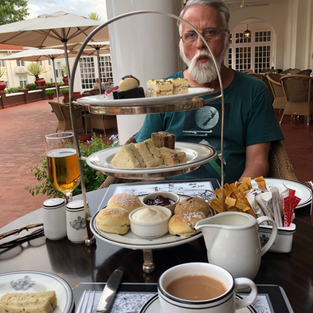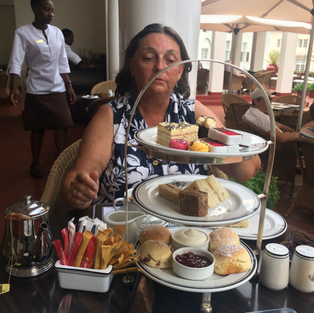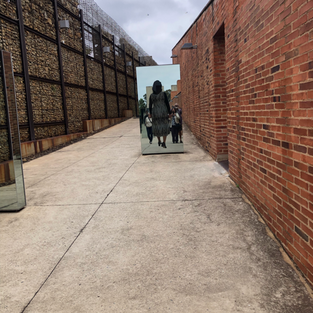Zimbabwe and Johannesburg: Colonial Legacy in Africa
- Susan Donnelly
- Oct 3, 2020
- 6 min read
When we were planning our round the world trip, it seemed silly not to visit Victoria Falls, one of the seven natural wonders of the world and a UNESCO World Heritage site, when we were going to be so close. However, I didn’t do much research on it. It was just an add-on to our Botswana trip which Patricia included for us. She arranged the transportation and the hotel so it was just one less thing for me to worry about. Turns out, it would have been smart to check it out a little more.
The falls were named after Queen Victoria by David Livingstone, the legendary missionary and explorer who was the first European to see them. However, to the local people they were known as Mosi-oa-tunya, meaning the “Smoke that Thunders.” Listen to them thunder.
One might wonder why they would refer to the falls as ‘smoke’ that thunders rather than ‘water’ that thunders. Well, there is a good reason for that -- the thundering water sends up such a thick spray of mist that it does look like smoke from a distance. We saw this from the terrace of the Victoria Falls Hotel in the afternoon. But more about that later.

In the morning, we had been picked up at our hotel in Kasane by a van taxi along with a German couple with dreadlocks and three young men who didn’t speak any English, at least not to us. We had to get out at the border to get our visas and so did about a hundred other tourists from a variety of buses and taxis. This turned out to be the most chaotic border crossing we experienced in our whole trip. It was a free-for-all. People from many countries, speaking dozens of languages, crowded around the immigration windows, with no one really knowing what we were supposed to be doing.

Gradually, information from the front passed through the crowd -- you had to pay cash for your visa -- different amounts for different countries. It turned out we had to pay $30 for David as a US citizen and $75 for me as a Canadian.

But, I have to admit, it was the most impressive visa we got on the trip -- it wasn’t the usual simple stamp; it was pasted in and took up a whole page of the passport.
It took more than an hour, but eventually, we reunited with our driver and continued on to the town of Victoria Falls. He took us to a parking lot across the street from the main entrance to the falls. It was a baking hot sunny day so we took hats, sunglasses, sun screen and photo equipment and set off, leaving the rest of our luggage in the van. But, this is where a little prior research would have come in handy.

As you can see on the map, the walking trail along the edge of the cataract goes through the Victoria Falls “Rainforest” Reserve and a rainforest is a rainforest because of all the rain that falls on it. Usually, the rain comes from clouds in the sky, but here the “rain” comes from the roaring mist rising from the bottom of the falls up and over the rim of the cataract.
The sky was still clear at the Devil’s Cataract and the beginning of the main falls.

We began to feel a little drizzle as we walked through the beautiful cool rainforest heading towards lookout number 9.
However, when we reached the lookout, we realized that we should have brought our rain gear which was still tucked into our luggage in the van. This is the last we saw of the falls.

From this point on, we couldn’t even see the falls because of the thick mist, although we could continue to hear the roar and we certainly felt the rain.
By the time we got to lookout number 12 we were completely soaked to the skin and all we could do was laugh at our own stupidity. We took the next right turn back towards the entrance and headed for a hot drink and some lunch at the cafe. Along the way, we came across this beauty in the greenery.

Later, after checking into our hotel and a short rest, we walked from our very modest accommodations to the very elegant Victoria Falls Hotel for high tea on the verandah which looks out over lush lawns towards the falls in the distance.
Walking through the enormous lobby with spectacular architecture and furnishings, one could easily imagine a scene from its colonial past, perhaps King George VI and his entourage visiting in 1946. Originally built in 1904, the hotel accommodated passengers on the new railway commissioned by Cecil Rhodes, head of the British South Africa Company. For a time, the country was even called Rhodesia in honor of this business tycoon. His plan was to extend the railway from Capetown in the south to Cairo in the north, but the section through the center of the continent was never completed. However, coincidentally, we rode on a northern section of the railway during our stay in Egypt the next month - more on that in a future post.
The high tea was elaborate and delicious. I had a hard time deciding what to eat first.
While we ate, we were amused watching monkeys climbing in the open windows of guests’ rooms from upper floor balconies and making off with their belongings -- heaven knows what their loot was or what they did with it. Also, a family of warthogs made their way across the lawn, creating great excitement among the guests who rushed to get photos of the wild beasts. We were relieved to see that the mama didn’t get alarmed and gore someone in an effort to protect her babies.
The next day, we made the trek back across the border into Botswana where we felt more at home. In Zimbabwe, as white tourists, we felt like remnants of an oppressive class; in Botswana, we felt like honored guests. The difference in the histories of the two countries probably explains a lot in this regard. As the colonization of southern Africa progressed through the 1700s and 1800s, Botswana became surrounded by German, Dutch and British colonies that were exploited ruthlessly by the Europeans. However, Botswana was never itself a colony. To the south and east, there was almost constant violence between the tribes and the white colonists but Botswana remained relatively peaceful. Today, there is an advisory body to the elected parliament composed of chiefs representing the various tribes living within the country.

When we got back to Maun, we had a last visit with Patricia to say a sad goodbye before we were taken to the airport for our flight to Johannesburg, where we were to stay two nights for a little rest before a long, gruelling flight to Morocco.
In Johannesburg, or Joburg as the locals call it, we stayed in a lovely little place very close to the airport, the Dove’s Nest Guest House. It had a shady garden with huge trees and a tinkling fountain and we had our own balcony where we could relax with a glass of chilled white wine.
During our one day in Johannesburg, we decided to visit the Apartheid Museum where there are extensive exhibitions illustrating the rise and fall of apartheid in South Africa, inluding the life and struggles of Nelson Mandela.

Throughout the museum, the stories are told through artworks, films and artifacts in such a way as to give visitors a sense of the personal experiences of people who lived through this incredible period of history. Every detail, including the construction of the walls along the entryway, has significance.
We don’t have photos of the exhibits as it was quite dark inside the museum and we became immersed in the whole experience. It was very educational and well worth the time. After the main exhibit about apartheid, there was an additional exhibit relating the South African experience to other types of slavery that continue in various parts of the world today -- a Thai man held captive for years on a fishing boat, women kidnapped and sold into sex slavery, children forced to work in sweatshops. The struggle for freedom and human dignity is far from over, as we know full well in the United States.
On the way back to our hotel, we asked our black taxi driver about his experience and had a discussion about the current situation in the country. Although things are better since apartheid, it sounds like relations between whites and blacks are still complicated.
The next day, we set off for north Africa.
























Comments